IAMM Mosques

Beez Neez now Chy Whella
Big Bear and Pepe Millard
Sat 31 Dec 2016 23:37
|
Islamic Arts Museum Malaysia –
Mosques
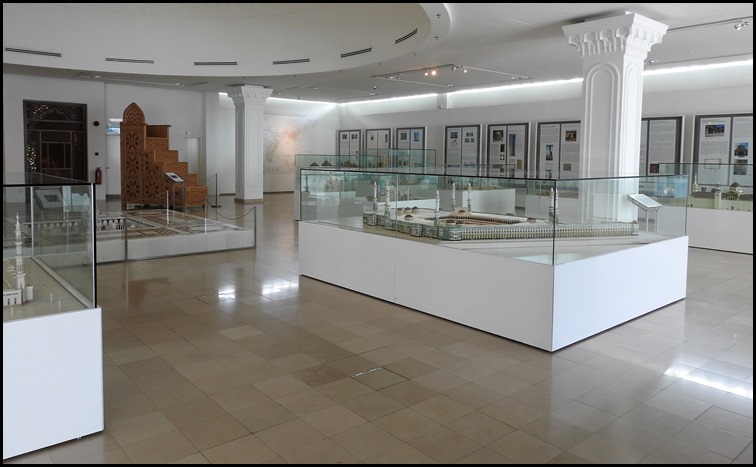 After a cold drink in the gorgeous restaurant we took the lift to the
top floor, there we found a gallery all about
Mosques.
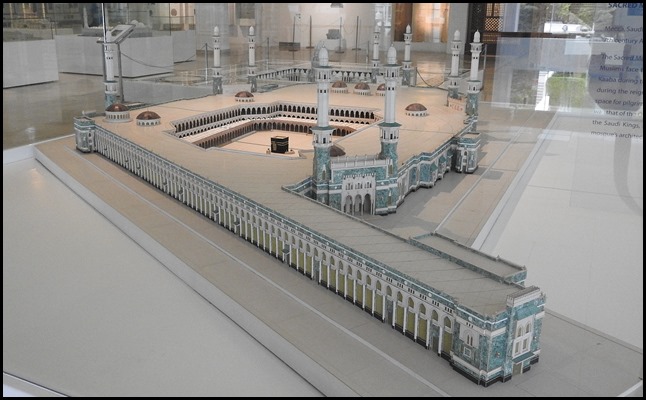 Mecca dominated
the huge space.
 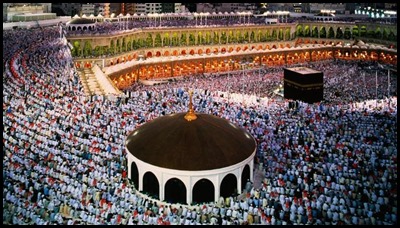 Mecca can hold
around 900,000 people (I found a picture during
prayers).
Sacred Mosque (Al Masjid Al
Haram), Mecca, Saudi Arabia, 7th century: The Sacred Mosque is the
holiest site in Islam. Situated in the Holy City of Mecca, Al Masjid Al Haram is
the direction towards which Muslims face to perform their daily prayers. It is
also the site where millions of pilgrims gather to circumambulate around the
Holy Kaaba during the Hajj season It is the only mosque in the world that has
neither a qibla wall nor mihrab.
(Mihrab is
a semi-circular niche in
the wall of a mosque that
indicates the qibla;
that is, the direction of the Kaaba in Mecca and
hence the direction that Muslims should
face when praying. The wall in which a mihrab appears
is thus the "qibla wall").
Wiki says: The Kaaba ("The Cube") also referred as Al Kaaba Al Musharrafah (The Holy Kaaba), is a building at the centre of Islam's most sacred mosque. It is considered the "House of Allah" and has a similar role to the Tabernacle and Holy of Holies in Judaism. Wherever they are in the world, Muslims are expected to face the Kaaba when performing salat (prayer). From any point in the world, the direction facing the Kaaba is called the qibla. The sanctuary around the Kaaba is called Al-Masjid al-Haram (Sacred Mosque). One of the Five Pillars of
Islam requires every Muslim who is able to do
so to perform the hajj pilgrimage at least once in their
lifetime. Multiple parts of the hajj require pilgrims to make tawaf, the circumambulation seven times around the Kaaba in a
counter-clockwise direction. Tawaf is also performed by pilgrims during the umrah (lesser pilgrimage). However, the most interesting times are
during the hajj, when millions of
pilgrims gather to circle the building within a 5-day period. In 2013, the number of pilgrims coming
from outside the Kingdom of Saudi Arabia to perform hajj was officially reported as
1,379,531.
Architecturally, it was during the reign of the second
righteous caliph, Omar ibn al Kattab, that the Kaaba was enclosed with a wall,
providing a confined space for pilgrims. Since then, the mosque has been
constantly reconstructed and enlarged. Among the major reconstruction stages was
that of the Ottoman Sultan Selim II, who commissioned chief architect Mimar
Sinan to renovate and refurbish the mosque. Under the Saudi Kings,
state-of-the-art technologies were employed to provide the utmost comfort to
pilgrims. This model reflects the mosque’s architecture from the year
1998.
 Tengkera
Mosque, Malacca, Malaysia, 18th century: Constructed around
1728, the Tengkera mosque is one of the oldest surviving mosques in Malacca,
commissioned by the Dutch during the colonial period. Its roof design and
ornamentation utilises a blend of Malay with Javanese forms. It further
incorporates a pagoda-shaped minaret that reflects the influence of Chinese
architectural style, with ceramic tiles imported from the Qing Empire (1644 –
1799). Buried in the grounds of the mosque is Sultan Hussein Shah, the Johor and
Singapore ruler of the 19th century, who signed over Singapore to Thomas
Stamford Raffles in 1819.
 The Art of the
Mosque: The art of the mosque is infinite in variety, while
at the same time exhibiting certain universal characteristics and functional
units. Facing toward the Ka’ba in Mecca, an intricately carved mihrab marks the
direction of prayer. The niche set into the wall is adorned with coiled foliate
arabesque and bands of calligraphy. At the base of this mihrab lies a prayer rug
and an unfolded rehal or wooden Quran stand, where
the divine revelation can be recited. The mimbar, the pulpit from which the Imam
delivers his sermon (khutbah) during Friday prayers, has evolved over time from
a few modest steps, into an art form. The suspended mosque
lamp illuminates a verse of the Quran: “Allah is the light of the skies
and the universe”. From outside comes the resonating sound of the ‘azan, the
rhythmic call to prayer.
 Tucked around the corner we found a flat-screen Qur’an presentation. This recitation of the
Qur’an by the celebrated Egyptian imam Muhammad Jebril had a black square moving
along the English words and opposite on the Arabic. We stood for a while to
listen to, in this case, the words of Yusuf ‘Ali. So harmonious and easy on the
ear.
 This Kiswa was
in a different gallery but it fits better here.
 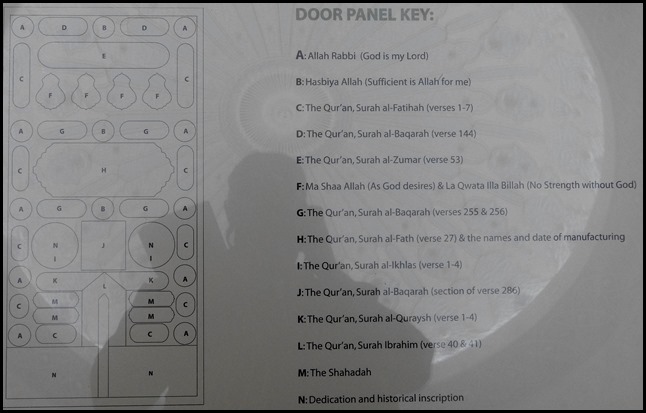 The
Kiswa. “The first House (of worship) appointed for men was that
at Bakka: Full of blessing and of guidance for all kinds of beings:” (The
Qur’an, Surah Al-Imran, verse 96)
The Holy Ka’aba is located at the
centre of the mosque known as Masjid al-Haram in Mecca, the important sanctuary
for Muslims. The Ka’aba is known by several names, including al-Bait al Atiq
(the ancient or liberated house) and Bait al-Haram (the sacred and honourable
house).
The walls of the Ka’aba are covered
with a curtain called the Kiswa. Today, it is made in Mecca of black silk with
calligraphic verses in thuluth script inscribed in a zigzag pattern, black
against black.
The cloth shown here is the door
curtain of the Ka’aba, known as the Sitara or Burqu’. Fully embroidered with
gold and silver calligraphic inscriptions, it draped the door of the Ka’aba in
1964, for the entire year. It is signed as the work of the Mecca factory of Abd
al-Rahim Ami. The inscriptions are placed within compartments supplemented by
floral motifs.
The Kiswa is finely embroidered in
several stages. These start with the sewing of cotton cords onto the black silk
cloth to form the curvature of the inscriptions and decorations. The process is
completed when the gold-plated silver threads cover all the cotton
cords.
.
 Mamluk
Inspired Fountain, marble mosaic, 19th century: The fountain
reflects the Mamluk design and style, found in homes and palaces of Egypt and
Syria (13th – 16th century). They were placed as a focal point of enclosed
courtyard house gardens, or in a dominant room, called ‘Iwan’. Strategically
situated, these fountains function as a source of air cooling as well as for
decorating the main guest room.
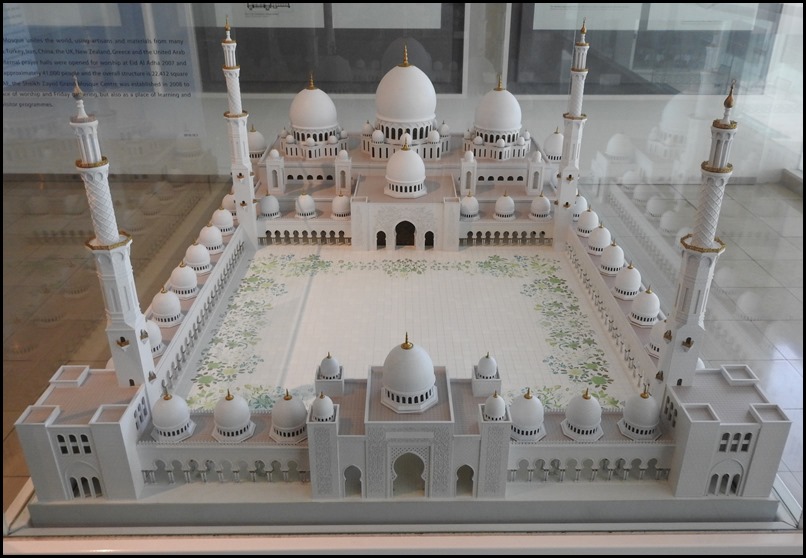 Sheik Zayed
Grand Mosque Complex, Abu Dhabi, United Arab Emirates, 2007:
In its design and construction, the Sheik Zayed
Grand Mosque unites the world, using artisans and materials from many countries,
including Italy, Germany, Austria, Morocco, Turkey, Iran, China, the UK, New
Zealand, Greece and the United Arab Emirates. Construction began in November
1996; the internal prayer halls were opened for worship at Eid Al Adha in 2007
and have remained so since then. The maximum capacity is approximately 41,000
people and the overall structure is 22,412 square metres. As one of the most
visited buildings in the UAE, the Sheik Zayed Grand Mosque Complex was
established in 2008 to manage the day-to-day operations, not only as a place of
worship and Friday gathering, but also as a place of learning and discovery
through its unique library, education and visitor programmes.
I saved our favourite
until last.
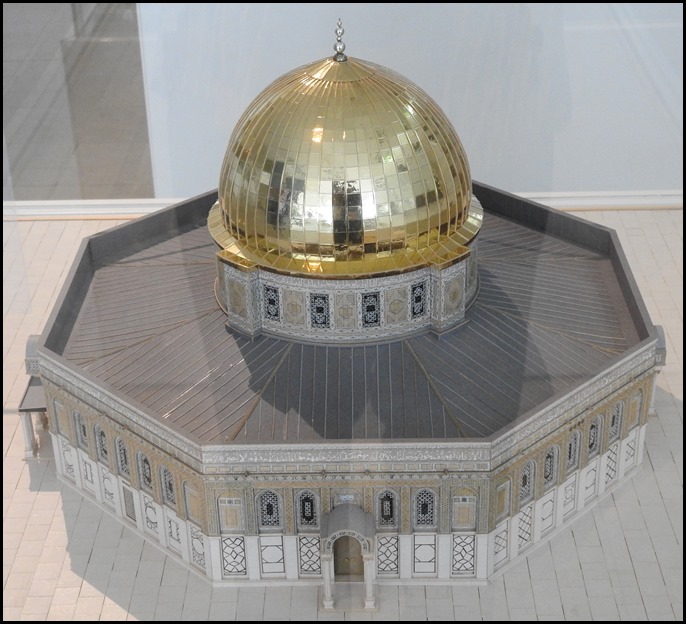 Dome of the
Rock (Qubbat Al-Sakhrah) Jerusalem, Palestine, 7th century:
The Dome of the Rock is the oldest Islamic structure to have survived in its
original form. It was constructed under the auspices of the Umayyad Caliph Abdul
bin Marwan, utilising the expertise of non-Muslim craftsmen. The interior and
exterior are decorated with glass mosaics reflecting geometric, vegetal and
calligraphic design echoing the Quranic verses describing paradise. The
octagonal ground plan of the shrine was modeled after Byzantine architecture and
was a jewel amongst the Christian buildings that surrounded it. A portion of the
shrine’s interior and exterior is lavishly decorated with coloured tiles fitted
by Sultan Suleyman the Magnificent in 1582. In 1993, 80 kilograms of gold was
donated by King Hussein of Jordan towards the refurbishment of the dome
covering. We have been lucky enough to see this majestic building on our
tour of the Holy Land.
 We left this floor heading down one, several Mosques now on
our list to visit.
ALL IN ALL STUNNING BEAUTY
INTERESTING TO LEARN A
LITTLE
|